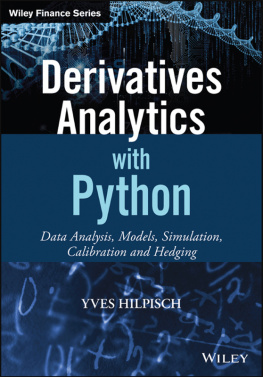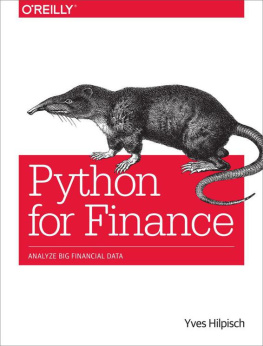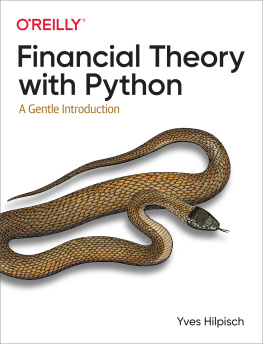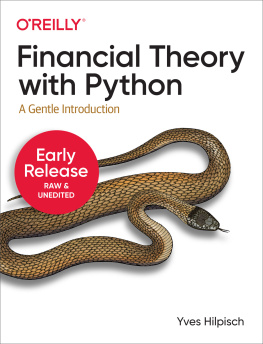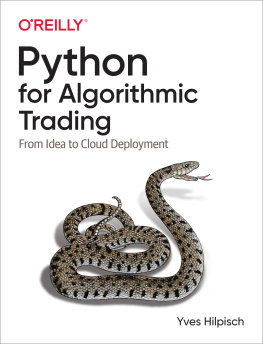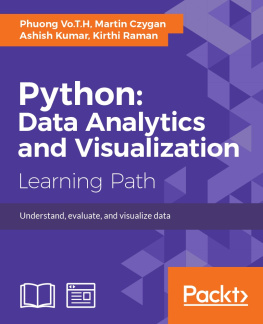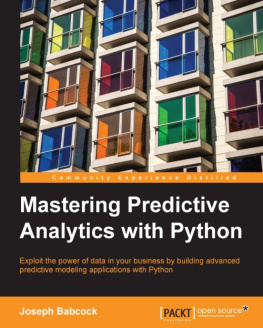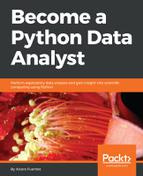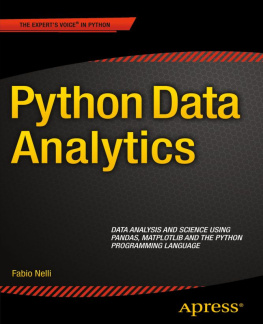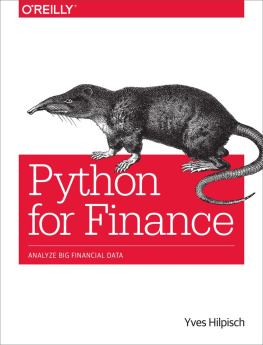Hilpisch - Derivatives analytics with Python : data analysis, models, simulation, calibration and hedging
Here you can read online Hilpisch - Derivatives analytics with Python : data analysis, models, simulation, calibration and hedging full text of the book (entire story) in english for free. Download pdf and epub, get meaning, cover and reviews about this ebook. City: Chichester, year: 2016, publisher: John Wiley & Sons Ltd, genre: Computer. Description of the work, (preface) as well as reviews are available. Best literature library LitArk.com created for fans of good reading and offers a wide selection of genres:
Romance novel
Science fiction
Adventure
Detective
Science
History
Home and family
Prose
Art
Politics
Computer
Non-fiction
Religion
Business
Children
Humor
Choose a favorite category and find really read worthwhile books. Enjoy immersion in the world of imagination, feel the emotions of the characters or learn something new for yourself, make an fascinating discovery.
Derivatives analytics with Python : data analysis, models, simulation, calibration and hedging: summary, description and annotation
We offer to read an annotation, description, summary or preface (depends on what the author of the book "Derivatives analytics with Python : data analysis, models, simulation, calibration and hedging" wrote himself). If you haven't found the necessary information about the book — write in the comments, we will try to find it.
Hilpisch: author's other books
Who wrote Derivatives analytics with Python : data analysis, models, simulation, calibration and hedging? Find out the surname, the name of the author of the book and a list of all author's works by series.
Derivatives analytics with Python : data analysis, models, simulation, calibration and hedging — read online for free the complete book (whole text) full work
Below is the text of the book, divided by pages. System saving the place of the last page read, allows you to conveniently read the book "Derivatives analytics with Python : data analysis, models, simulation, calibration and hedging" online for free, without having to search again every time where you left off. Put a bookmark, and you can go to the page where you finished reading at any time.
Font size:
Interval:
Bookmark:

For other titles in the Wiley Finance series
please see www.wiley.com/finance
This edition first published 2015
2015 John Wiley & Sons Ltd
Registered office
John Wiley & Sons Ltd, The Atrium, Southern Gate, Chichester, West Sussex, PO19 8SQ, United Kingdom
For details of our global editorial offices, for customer services and for information about how to apply for permission to reuse the copyright material in this book please see our website at www.wiley.com.
All rights reserved. No part of this publication may be reproduced, stored in a retrieval system, or transmitted, in any form or by any means, electronic, mechanical, photocopying, recording or otherwise, except as permitted by the UK Copyright, Designs and Patents Act 1988, without the prior permission of the publisher.
Wiley publishes in a variety of print and electronic formats and by print-on-demand. Some material included with standard print versions of this book may not be included in e-books or in print-on-demand. If this book refers to media such as a CD or DVD that is not included in the version you purchased, you may download this material at http://booksupport.wiley.com. For more information about Wiley products, visit www.wiley.com.
Designations used by companies to distinguish their products are often claimed as trademarks. All brand names and product names used in this book are trade names, service marks, trademarks or registered trademarks of their respective owners. The publisher is not associated with any product or vendor mentioned in this book.
Limit of Liability/Disclaimer of Warranty: While the publisher and author have used their best efforts in preparing this book, they make no representations or warranties with respect to the accuracy or completeness of the contents of this book and specifically disclaim any implied warranties of merchantability or fitness for a particular purpose. It is sold on the understanding that the publisher is not engaged in rendering professional services and neither the publisher nor the author shall be liable for damages arising herefrom. If professional advice or other expert assistance is required, the services of a competent professional should be sought.
Library of Congress Cataloging-in-Publication Data
Hilpisch, Yves J.
Derivatives analytics with Python : data analysis, models, simulation, calibration and hedging / Yves Hilpisch.1
pages cm.(The Wiley finance series)
Includes bibliographical references and index.
ISBN 978-1-119-03799-6 (hardback)
1. Derivative securities. 2. Hedging (Finance) 3. Python (Computer program language)I. Title.
HG6024.A3H56 2015
332.64'5702855133dc23
2015010191
A catalogue record for this book is available from the British Library.
ISBN 978-1-119-03799-6 (hardback) ISBN 978-1-119-03793-4 (ebk)
ISBN 978-1-119-03800-9 (ebk) ISBN 978-1-119-03801-6 (obk)
Cover Design: Wiley
Cover Images: Top image (c)iStock.com/agsandrew; Bottom image (c)iStock.com/stocksnapper
This book is an outgrowth of diverse activities of myself and colleagues of mine in the fields of financial engineering, computational finance and Python programming at our company The Python Quants GmbH on the one hand and of teaching mathematical finance at Saarland University on the other hand.
The book is targeted at practitioners, researchers and students interested in the market-based valuation of options from a practical perspective, i.e. the single numerical and technical implementation steps that make up such an effort. It is also for those who want to learn how Python can be used for derivatives analytics and financial engineering. However, apart from being primarily practical and implementation-oriented, the book also provides the necessary theoretical foundations and numerical tools.
My hope is that the book will contribute to the increasing acceptance of Python in the financial community, and in particular in the analytics space. If you are interested in getting the Python scripts and IPython Notebooks accompanying the book, you should visit http://wiley.quant-platform.com where you can register for the Quant Platform which allows browser-based, interactive and collaborative financial analytics. Further resources are found on the website http://derivatives-analytics-with-python.com. You should also check out the open source library DX Analytics under http://dx-analytics.com which implements the concepts and methods presented in the book in standardized, reusable fashion.
I thank my familyand in particular my wife Sandrafor their support and understanding that such a project requires many hours of solitude. I also want to thank my colleague Michael Schwed for his continuous help and support. In addition, I thank Alain Ledon and Riaz Ahmad for their comments and feedback. Discussions with participants of seminars and my lectures at Saarland University also helped the project significantly. Parts of this book have benefited from talks I have given at diverse Python and finance conferences over the years.
I dedicate this book to my lovely son Henry Nikolaus whose direct approach to living and clear view of the world I admire.
YVES HILPISCH
Saarland, February 2015
A Quick Tour
This book is about the market-based valuation of (stock) index options. In the domain of derivatives analytics this is an important task which every major investment bank and buy-side decision maker in the financial market is concerned with on a daily basis. While theoretical valuation approaches develop a model, parametrize it and then derive values for options, the market-based approach works the other way round. Prices from liquidly traded options are taken as given (i.e. they are inputs instead of outputs) and one tries to parametrize a market model in a way that replicates the observed option prices as well as possible. This activity is generally referred to as model calibration. Being equipped with a calibrated model, one then proceeds with the task at hand, be it valuation, trading, investing, hedging or risk management. A bit more specifically, one might be interested in pricing and hedging an exotic derivative instrument with such a modelhoping that the results are in line with the overall market (i.e. arbitrage-free and even fair) due to the previous calibration to more simple, vanilla instruments.
To accomplish a market-based valuation, four areas have to be covered:
- market: knowledge about market realities is a conditio sine qua non for any sincere attempt to develop market-consistent models and to accomplish market-based valuation
- theory: every valuation must be grounded on a sound market model, ensuring, for example, the absence of arbitrage opportunities and providing means to derive option values from observed quantities
- numerics: one cannot hope to work with analytical results only; numerical techniques, like Monte Carlo simulation, are generally required in different steps of a market-based valuation process
- technology: to implement numerical techniques efficiently, one is dependent on appropriate technology (hard- and software)
This book covers all of these areas in an integrated manner. It uses equity index options as the prime example for derivative instruments throughout. This, among others, allows to abstract from dividend related issues.
The book is divided into three parts. The first part is concerned with market-based valuation as a process and empirical findings about market realities. The second part covers a number of topics for the theoretical valuation of options and derivatives. It also develops tools much needed during a market-based valuation. The third part finally covers the major aspects related to a market-based valuation and also hedging strategies in such a context.
Font size:
Interval:
Bookmark:
Similar books «Derivatives analytics with Python : data analysis, models, simulation, calibration and hedging»
Look at similar books to Derivatives analytics with Python : data analysis, models, simulation, calibration and hedging. We have selected literature similar in name and meaning in the hope of providing readers with more options to find new, interesting, not yet read works.
Discussion, reviews of the book Derivatives analytics with Python : data analysis, models, simulation, calibration and hedging and just readers' own opinions. Leave your comments, write what you think about the work, its meaning or the main characters. Specify what exactly you liked and what you didn't like, and why you think so.

